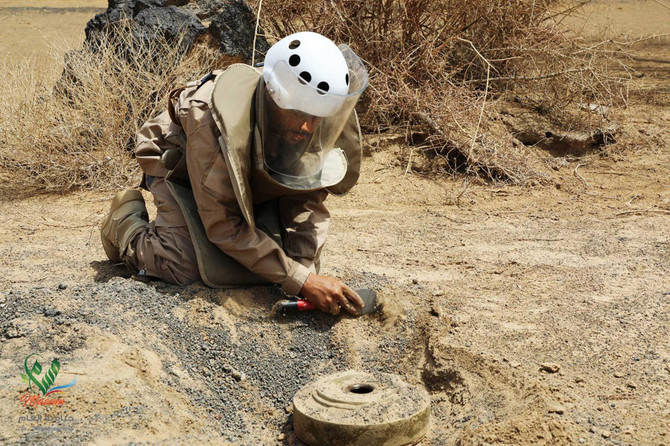Houthis Carpeting the Ground in Yemen With Land Mines
"The scale of the problem is exceptionally large, and the impact is horrendous."
"Most of the casualties we see reported are civilians."
Loren Persi Vicentic, Landmine Monitor
"This is a war, so what do you expect us to do?"
"Receive the other side with flowers?"
General Yahia al--Sarie, Houthi officer
"The problem is the enemy's inhumane weapons, the land mines and improvised explosives."
Saudi Brigadier General Mohsen al-Khabi
 |
| Land mines scattered by Houthis will remain a threat even if the latest negotiations succeed in halting the civil war. (AP) |
"Mines today exist in every single area of Yemen."
"It’s not being used as a defensive [or] offensive mechanism. It’s being used to terrorize the local population across Yemen."
Ousama Al-Gosaibi, program manager, Saudi-funded Masam demining project
The Geneva Conventions ban hidden mines and anti-personnel mines for use during war situations. Houthi officials claim they make use only of anti-tank mines and only on battlefields, not mines that are triggered by human footsteps, much less place any of them in civilian areas.
Independent observers and investigative reporters however, examined defused land mines to get a better understanding of what exactly has been occurring, with Saudi Arabia calling attention to Houthi mines. A war crime, to be sure. On the other hand, both the Kingdom of Saudi Arabia and the United Arab Emirates, battling the insurgent Houthis backed by Iran, have themselves committed war crimes through airstrikes killing civilians.
Their imposition of a partial blockade has placed the impoverished Arab country in a famine situation, desperately needing food relief and earning them the censure of the UN for what that's worth. It is, however, undeniable that all of the land mines and other explosive devices buried in Yemen were placed by Houthis, according to independent monitors. And mining represents a typical tactic used by a military force defending territory or retreating from it.
Nor is it exclusively military forces that make use of these IEDs and other explosives; infamously the U.S.-and-NATO-led mission against the Taliban in Afghanistan came up against the planting of IEDs, horribly destructive, killing and wounding civilians, farmers, children, foreign aid personnel, diplomatic and military staff. Islamic State fighters, the last of which are now being routed out of Syria by the Kurdish-led militias have been feverishly planting IEDs whose only purpose is indiscriminate death.
Saudi and Yemeni commanders speak of the presence of hundreds of thousands of unmarked land mines planted by the Houthis and valued by them as their most formidable defense against the better-armed and trained military forces. The conflict has been in near-standstill, irrespective of the Saudis' superior air power and allied resources of the Saudi-led coalition, because of the hidden explosives.
Untrained soldiers have been dispatched by the Saudi forces to clear minefields. "I removed two and the third one exploded" Sultan Hamad, a 39-year-old Yemeni soldier explained of the loss of a leg as he cleared mines on the front line near Marib in central Yemen. Over a half-dozen soldiers awaited fittings for prosthetic limbs at a Marib clinic.
Thousands of civilians have been wounded by the mines, along with an estimated 920 civilians killed, rights groups and other monitors stating the minefields will ensure that Yemen remains riddled with buried explosives to kill and maim unsuspecting civilians for decades until such time as the devices can be removed as occurred in Afghanistan, Colombia and Cambodia.
The Saudis hired a Western mine-removal company which has estimated that over a million mines were laid by the Houthis, a number that represents more than one mine for every 30 Yemenis; a concentration as high as compared to any other country post World War II in deadly conflicts. There are so many land mines placed along roads and among scattered settlements that the advance of Yemeni forces has remained in the same position for years.
Controlling much of northern Yemen, including Sanaa, Houthi authorities, in spite of the civilian casualties continue to claim they are not responsible for the thousands of injuries and deaths. In the last four years several Houthi missile parts have been recovered by the Saudis identified as coming from Iran. The Houthis themselves have established factories in production of thousands of their own land mines, each stamped with Arabic serial numbers.
Saudi-backed Yemeni soldiers showed off Houthi land mines, some disguised as small boulders with hidden infrared motion detectors. Close by in the district of Hairan in the desert of northern Yemen lay a heaped hill of over 4,000 mines recovered in the past several months. Houthis, according to Deif Ahmed Abdullah Saleh, a Yemeni army officer, were "carpeting the ground" with them.
During the Iraq-Iran war, the Ayatollahs convinced young Iranian teens to walk through fields planted with mines, carrying with them 'keys' to enter Paradise, so they could sweep through the area as human sacrifices, the youths 'martyred' as their presence set off the explosives to enable the Iranian armed forces to later proceed unharmed.
 |
| A member of Yemeni government forces holds mines during fighting against Houthi rebels in the western port city of Hodeidah, Yemen, 19 June 2018. EPA |
Labels: Conflict, Houthis, Iran, Land Mines, Saudi Arabia, Yemen

<< Home